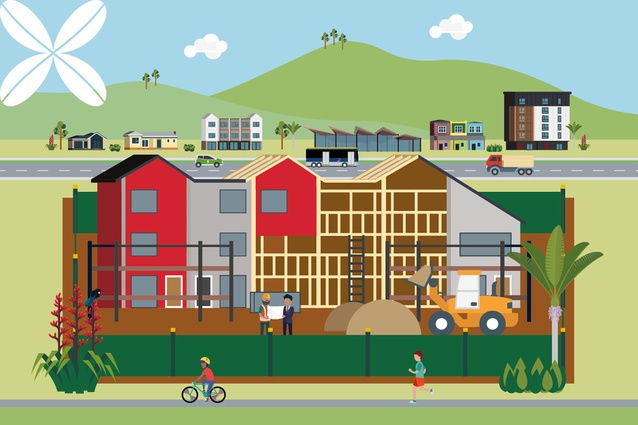Auckland’s new planning rules — what you have to know
Significant changes to Auckland’s planning rules came into effect on 18 August 2022, enabling higher-density housing to be built across the region. ArchitectureNow teamed up with Auckland Council to provide an outline of what you need to know.
The new central government rules, the Medium Density Residential Standards (MDRS), require high-growth councils across New Zealand to introduce seven new standards that will ease planning rules for what can be built without a resource consent.
For many Auckland property owners, this means they will now be allowed to build up to three homes of up to three storeys on their site, such as townhouses and terrace housing.
Central government has introduced two big planning reforms to enable more higher density housing — the National Policy Statement on Urban Development (NPS-UD) and the new Medium Density Residential Standards.
These changes are significant to Auckland’s planning landscape. The NPS-UD requires Auckland Council to enable buildings of six storeys or more within walking distances (walkable catchments) from the city centre, our 10 large metropolitan centres and around rapid transit stops, including Auckland’s train and busway stations.
While the new Medium Density Standards have immediate legal effect from 18 August 2022, the process to decide exactly how the NPS-UD policies will become operative has just begun. The proposed plan change has been publicly notified today for people to make submissions. An independent hearings panel will then review all submissions and make recommendations to council on changes to the Auckland Unitary Plan — our city’s planning rulebook — over the next 12-18 months.
Who benefits from the new Medium Density Standards?
The density rules apply to all properties in residential zones that are not subject to a ‘qualifying matter’, or exemption to limit building heights and density in some areas.
Auckland Council’s notified plan change has reduced the four previous residential zones (Single House, Mixed Housing Suburban, Mixed Housing Urban, and Terrace Housing and Apartment Buildings — THAB) that applied in urban areas into the following three:
- Terrace Housing and Apartment Buildings Zone (now allowing for buildings of six storeys or more)
- Mixed Housing Urban Zone (incorporating the new medium density standards)
- Low Density Residential Zone (limited height and density where some qualifying matters apply)
Click here to find out what zone a property is now in, and whether there are any qualifying matters applied to it.
The following zones are excluded from the new Medium Density Residential Standards:
- Large Lot Zone
- Rural Coastal and Settlement Zone
- Single House Zone and Mixed Housing Suburban Zone in towns and villages where 2018 census recorded population as less than 5,000 (e.g. Wellsford)
Limits to density – the qualifying matters
Some areas can be exempt from the six and three-storey requirements and the new design standards based on qualifying matters.
These are characteristics within some areas that allow for intensification to be limited, such as protecting sites of cultural, historic, or ecological significance or avoiding development in areas with natural hazards or, where there are certain infrastructure constraints. However, a qualifying matter can only apply if there is strong evidence provided to justify an exemption.
The new medium density residential standards will not apply to properties with a proposed qualifying matter until final decisions are made in 2024 at the conclusion of the decision-making process. At that point, a proposed qualifying matter could be confirmed, removed or adjusted.
What stays the same
As with any new development, there is potential impact on the environment and other people. It therefore remains a requirement that new developments comply with all other rules and standards before construction begins.
Although the new medium density standards remove the need for most property owners to seek resource consent to develop their properties for up to three dwellings, there are other resource consenting requirements that remain as part of the Resource Management Act.
It is therefore likely that any property owner who intends to utilise the new medium density standards will require resource consent approval to subdivide the site, as well as assess the earthworks needed for construction of the new dwellings.
All building plans will still be subject to a building consent process, and as part of this assessment, Auckland Council will consider if any resource consents are also required. If any are needed, the building consent will be paused until resource consent has been obtained.
Auckland Council’s resource consents team advises anyone looking to develop their property to discuss with their industry professional (planner, architect, draftsperson, builder) what regulatory requirements they can expect.
Building four or more dwellings
For developments of four or more dwellings, the new standards do not take immediate effect. This means anyone looking to develop four or more dwellings on a site will still require resource consent approval under the current operative standards of the Auckland Unitary Plan.
Given that the new standards will enable significantly higher density development in many locations, Auckland Council has introduced new policies through the plan change to strengthen urban design outcomes. These design considerations include a greater focus on architectural form and detail. This is to ensure that we see ‘density done well’.
The new Medium Density Residential Standards

For more information, please visit ourauckland.nz/housingrules










